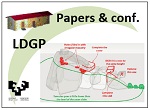Técnicas y criterios para la documentación geométrica de la excavación del dolmen «Alto de la Huesera» (Álava, España) y su reconstrucción virtual
Date
2020-06Author
Múgica Alustiza, José Antonio
Rodriguez-Miranda, Alvaro
Metadata
Show full item record
Fernández-Eraso, J., Mujika-Alustiza, J.A., Valle Melón, J.M., & Rodríguez Miranda, Á. 2020. Techniques and criteria for the geometric documentation of the excavation of the dolmen ‘Alto de la Huesera’ (Álava, Spain) and its virtual reconstruction. In Florian Cousseau & Luc Laporte (eds.) “Pre and Protohistoric Stone Architectures. Comparisons of the social and technical contexts associates to their buildings. Proceedings of the XVIII UISPP World Congress (4-9 June 2018, Paris, France), Volume 1, Session XXXII-3”. Archaeopress. ISBN 978-1-78969-545-8, 978-1-78969-546-5 (e-Pdf), Chapter 5, pp. 74-85.
Abstract
[ES] El dolmen del “Alto de la Huesera” es una de las nueve estructuras funerarias en la cara sur de la sierra de Cantabria. Está localizado en el término municipal de Laguardia (Álava, España). Fue identificada en 1947 por Domingo Fernández Medrano, quien lo excavó al año siguiente. Cuando fue descubierto, sólo eran visibles las partes superiores de las losas verticales, con la cubierta caía en el interior de tal forma que se creyó que no existía una cubierta en sí, sino que la cámara estaba construida por ortostatos inclinados que se unían en la parte superior. Esta forma de aparente pirámide y el hecho de no localizarse ninguna traza del corredor hizo pensar que se trataba del único dolmen del área que carecía de corredor.
Entre los años 2010 y 2013, una nueva serie de trabajos descubrieron el corredor y completaron las excavaciones de la cámara y el túmulo. Posteriormente, el monumento fue restaurado y, actualmente, muestra un aspecto idealizado de cómo pudo haber sido en origen.
A la luz de todo lo anterior, el presente artículo trata aspecto relativos a la documentación geométrica, la representación virtual del aspecto original del monumento y la preservación y difusión de la información. [EN] The dolmen of ‘Alto de la Huesera’ is one of the nine funerary constructions
on the southern face of the Cantabrian mountain range. It is located in the municipality of Laguardia (Álava, Spain). It was identified in 1947 by Domingo Fernández Medrano, who excavated it the following year. When discovered, only the top of the vertical slabs of the chamber were visible, with the cover slab fallen inside, in such a way that it prompted the idea that it lacked a cover slab, in other words, that the chamber was build with leaning orthostates which joined at the upper part. This apparent pyramid-shape and the fact of not being able to locate any trace of the passage made people believe that it was the only dolmen of this area without one.
Between 2010 and 2013 a new series of works discovered the missing passage and completed the excavation of the chamber and the tumulus. Afterwards, the monument was restored and, at present, it shows an idealized view of how it
could have been originally.
In the light of the foregoing, the paper goes over the aspects concerning the geometric documentation, the virtual representation of the original state of the
monument and the preservation and dissemination of the information.
 Back
Back
